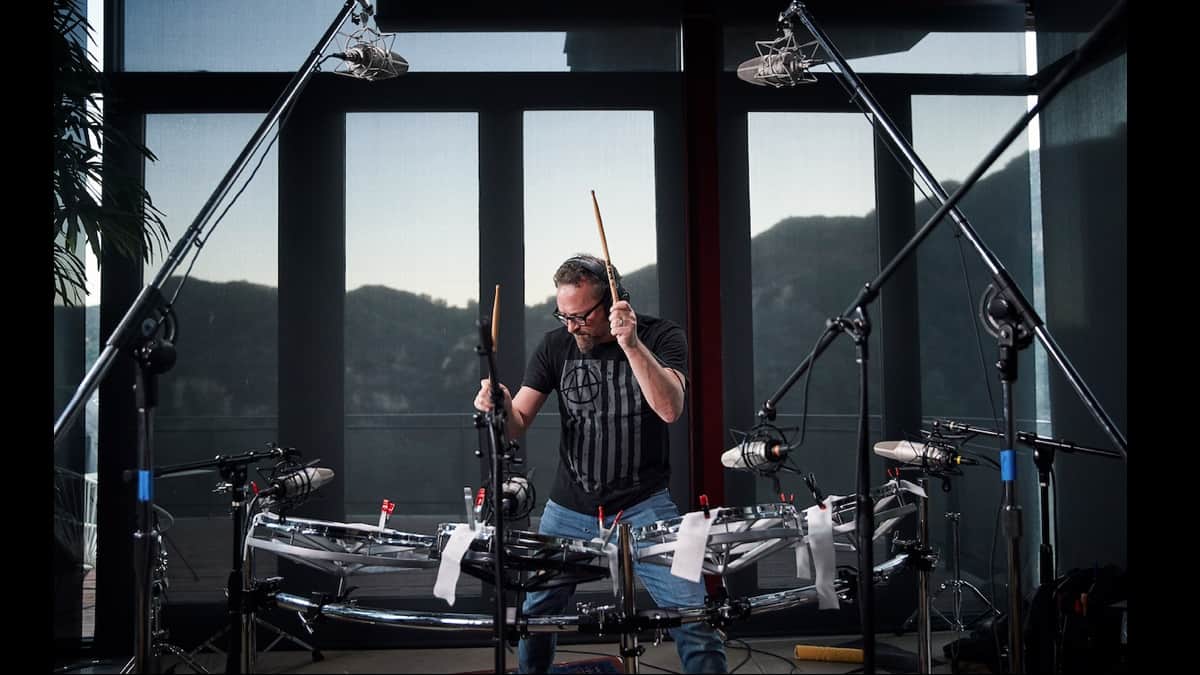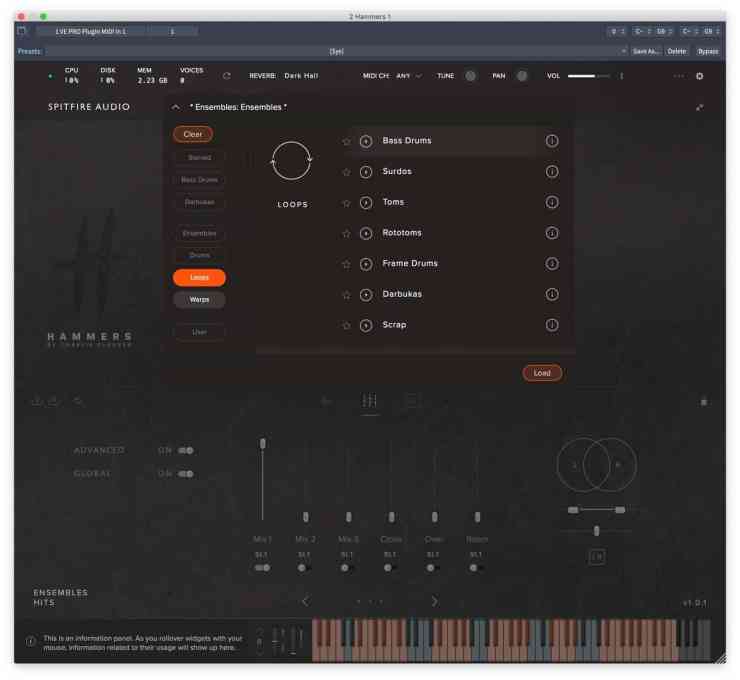In This Issue
Spitfire Audio Hammers Brutalist Drums: The Review

Charlie Clouser’s signature go-to percussion library is both gnarly and sensitive. Nick Batzdorf’s review is neither.
From the name and “cover” images, you’d expect Spitfire Audio’s Hammers (“Brutalist drums for maximum impact”) to sound not just big, but harsh, cold, stark, dark, concrete, hard-edged… brutal… those are some of the adjectives that could apply to Brutalist art and architecture.
Then when you see that it’s a signature library of Charlie Clouser’s percussion sounds, you don’t exactly think of polite, wimpy music recorded in a twee studio (twee = lace curtains, doilies under hard candy on a glass table, etc.).
And in fact there isn’t anything reserved about Hammers. The intro to this video is totally badass, and it shows off the big impact trailer aspect of the library extremely well. (It’s an interview, and it also shows you how much thought Clouser and Spitfire put into the library.)
But it’s funny how the same sounds can take on totally different meanings in different contexts. I first loaded up the library and made the following quick “unboxing” example before seeing that video or reading anything much about the instrument:
Nothing especially brutal there, right? Actually it’s Charlie’s hard-surface recording space that’s Brutalist, resulting in very clear, open recordings, rather than the library’s eight different drum types themselves:
The Brutalist room has a short decay, and Hammers was recorded through a variety of mics in different positions. Those who were worried that there would be no samples from inside the room’s chimney will be greatly relieved.
See where it says “Drums” to the left of Spitfire’s sample player? Those are individual hits. They’re recorded at different velocities, in round robins so you don’t keep triggering the same sample with every hit, and mapped nicely to the keyboard – it’s very playable.
You can select a variety of playing techniques and weapons (brushes, etc.) depending on the instrument, and sometimes one, two, or four hands pounding on the drums. By the way, “scrap” means scrap metal. Those instruments are part of what makes Hammers a unique percussion library.
That same list of Drums is also available as Loops and Warps (processed instruments). All the Drums and Warps are mapped the same way, so you can audition and replace instruments without re-recording or transposing the parts.
Hammers is 100GB on disk, but it doesn’t use up a whole lot of memory as sample libraries go. It can use a fair amount of CPU, but any modern computer should have no trouble with it.
Whole > parts + parts. First impression: this is a library whose whole is greater than the sum of its parts. That’s not to sneeze at the individual instruments, it’s saying that Hammers came to life when I sat back and listened to the default unboxing “ensemble” I’d sequenced above.
You really see all the musicians playing the instruments in front of you. Furthermore, one of the hallmarks of great recordings is that – at least on my system in my room – you can actually hear some vertical information coming from the two speakers, not just horizontal. That’s not in the recordings, just an unpredictable and happy accident, but it only happens with very clean recordings.
Now, that rave about the sound is a response to Mix 1, just the out-of-box default. There are additional preset mixes in the Spitfire sample player. Some of the mixes include heavy processing through all kinds of external effects, including pedal processors and Charlie’s Eurorack.
Regrettably, the price of the library license doesn’t include having him over to your house with his Eurorack. But the Spitfire player does include some effects and processors you can use yourself: a lowpass filter and a compressor (both single-knob more/less), a choice of pitch/time shifting processes, and a normalize function.
There’s also a selection of very credible impulse reverbs to add to the room sound. Unfortunately, as with all sample players in the known universe, Spitfire’s doesn’t have an audio input to run external signals through them. Thus the reverbs are only for Hammers and not external instruments you’re blending with the percussion ensemble.
The Cool People tend to use separate reverbs for things that would cloud a reverb mix – say, sub-rattling low hits – anyway. But this does have a place on one’s Things Wrong With the World list.
But is it a mixer? This mixer is called the Signal Mixer, because it doesn’t really behave the way you’d expect a mixer to behave. That’s partly because it’s often loading different samples rather than, say, fading between close and far mic positions that are already loaded.
The mixer also doesn’t have faders and assignable outputs for each percussion instrument, which is curious. Instead the separate outputs are for the different Signals.
In fact the library is set up for one instrument per instance. The only way to get more than one instrument on the keyboard in a single instance is to use the default Ensembles patch.
The solution is to copy recorded MIDI to separate DAW tracks with separate instances for each instrument for further refinement. There are those among us who might consider that suboptimal, but it is a workaround.

Still, to be absolutely brutalist, sometimes this sample player feels a little eccentric. If you raise the Sub fader, for example, why does the main mix cut off so you hear nothing but rumble? There’s usually a logical answer to be found, and in this case it’s a preference, but I have to question that being the default.
It also didn’t help when Logic threw up some “error syncing MIDI and audio” messages that I rarely see on my system. That is the reviewer’s fault for doing things that load samples while the DAW is playing, but still.
Okay, perspective. This is not close to being a deal-breaker – Hammers is an outstanding library in spite of that – but subjectively the Spitfire player combines very clever advanced features with, well, some missing basic ones.
.esreveR One of my favorite things in Hammers is its reversed samples, most notably how they’re implemented. You can have them load automatically with every instrument, or (to eliminate gratuitous memory use) just the ones for the instruments you’re going to use.
But sit down for this: you tell the Spitfire player how long they are to be, from 1/16th note to a whole note! So you play these in real time – no need for editing.
There’s some real intelligence going on here. If the reversed sample is very short and you have it set for a whole note, the Spitfire player waits until the right time to start it so that it ends up four beats later. What a great feature.
And as with many parameters, you can assign the reverse sample note value to a MIDI CC and vary it in real time. Assigning MIDI controls for real-time adjustments is easy in any DAW, but it also couldn’t be simpler to assign the parameter you choose from a list to the big wheel in the interface.
By the way, you can also turn reverse on and off in real time while Hammers instruments are playing to add some variety to parts.
Loops. These are rhythmically simple, very usable loops for each instrument, mapped to the keyboard. I for one appreciate that they’re not busy canned “beats” of marginal utility.
The loops that have me wagging my tail are the reverse ones at the bottom of the keyboard. That’s especially true of the bass drum hits, because by their nature they’re longer sounds.
By default the loop that’s selected will change to one that’s musically appropriate when you change the host tempo – another example of very clever programming.
Full circle. Circling back to how sounds can take on different characters in different contexts, Hammers is a surprisingly versatile library. Between its acoustic recordings and warps, it works very well in place of a standard drum set, in an orchestral setting, electronica, you name it.
The Spitfire player is good for their orchestral instruments, with one instrument (or group) per instance. But a high-end percussion library like this really wants at least basic mixer control over individual instruments, and separate outputs for them. On the other hand it does have some very clever features programmed in, and more importantly it’s mapped very well to the keyboard.
However, the far bigger picture is that Hammers is far bigger than its player. The recordings are spectacular; it plays really well; in a world of trailer boom-boom, it brings some subtlety and an organic character; it’s just different enough to be unique without being distracting… this is a legit go-to percussion library.
Price: $299
Click here for the product page























